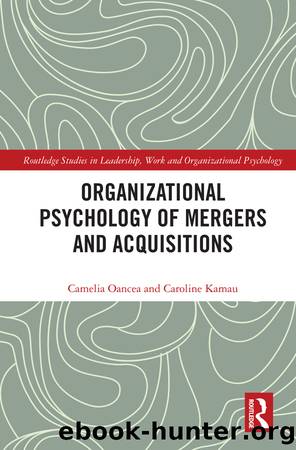Organizational Psychology of Mergers and Acquisitions by Oancea Camelia; Kamau Caroline;

Author:Oancea, Camelia; Kamau, Caroline;
Language: eng
Format: epub
Publisher: Taylor & Francis Group
Published: 2020-06-02T00:00:00+00:00
Rowold (2005) found that all five sub-types of transformational leadership are positively correlated, with coefficients ranging from approximately 0.3 to 0.5 when leaders were rated by colleagues of a similar rank, or ranging from 0.35 to 0.7 when leaders were rated by colleagues of a lower rank. We do not have information about whether Richard Branson conveys all five sub-types of transformational leadership, or information about the impact of his style of leadership on the success of acquisitions by Virgin, but it is plausible that such a successful entrepreneur can make an acquisition successful. Aside from his leadership, it plausible that Bransonâs personal drive, determination, and talent for spotting good business opportunities predict the success of his acquisitions as much as his style of leadership. Rather than delineating the indicators of leadership in the way that Bass and Avolio (2000) and Avolio and Bass (2004) do, some theorists conceptualise charismatic leadership more generally (House et al., 1991; Howell & Frost, 1989; House, 1977) because literature about transformational leadership and literature about charismatic leadership could broadly capture the same types of leaders (House & Podsakoff, 1994; Conger & Kanungo, 1998). Literature suggests that what matters is whether the leader is effective at inspiring employees to identify with and support his or her goals (Judge & Piccolo, 2004; Conger & Kanungo, 1998; DeGroot, Kiker, & Cross, 2000; Lowe, Kroeck, & Sivasubramaniam, 1996).
There are certain factors that can help a transformational leader be effective at motivating employees (Meindl, 1990). In theory, executives, managers, and supervisors with a transformational leadership style should inspire employees to accept and work towards supporting a merger or acquisition even if the employees were initially sceptical of the idea. Theoretically, the inspiration should happen when the leader charms employees into putting their trust in them, modelling positive behaviour such as being collaborative with staff from the partner organization, motivating employees to support the merger or acquisition by showing them how they can personally benefit (e.g. pay, promotion, doing work that harnesses their individual passions), and by leading discussions or activities about the merger or acquisition that the employees find intellectually stimulating. However, employees are unlikely to respond to the same leader in the same way, and therefore some employees are likely to end up more motivated about the merger or acquisition than others. For example, Shamir, House, and Arthur (1993) theorised that charismatic leaders do not produce the same effects or effects to the same extent among all employees because some factors facilitate or inhibit the influence of the leader on employees. It is plausible that the leaderâs behaviour needs to appeal to the existing values and identities of the employees and be perceived as similar to them in their value and goals. A charismatic leader is unlikely to have the same impact inspiring an employee who perceives work as a means to an end as on an employee who perceives work or tasks as an end in itself (Goldthorpe, Lockwood, Bechhofer, & Platt, 1968). Similarly, transformational leadership might
Download
This site does not store any files on its server. We only index and link to content provided by other sites. Please contact the content providers to delete copyright contents if any and email us, we'll remove relevant links or contents immediately.
Time Management Made Easy: How to Cultivate New Habits, Improve Productivity and Get Things Done by Joshua Strachan(2371)
The 7 Habits of Highly Effective People by Stephen R. Covey & Sean Covey(2164)
The Concise Laws of Human Nature by Robert Greene(1737)
Doesn't Hurt to Ask by Trey Gowdy(1566)
Primal Leadership by Daniel Goleman(1155)
Hook Point: How to Stand Out in a 3-Second World by Brendan Kane(1100)
HBR's 10 Must Reads 2021 by unknow(1051)
Don't Sweat the Small Stuff...and It's All Small Stuff by Richard Carlson(1028)
Amazon Unbound by Brad Stone(988)
100 Things Successful People Do by Nigel Cumberland(971)
HBR's 10 Must Reads 2021 by Harvard Business Review(963)
The Job Closer by Steve Dalton(945)
Master of One by Jordan Raynor(940)
Lives of the Stoics by Ryan Holiday & Stephen Hanselman(905)
Declutter Your Mind: A step by step guide to learn to control your thoughts, stop worrying, relieve anxiety and eliminate panic attacks and negative thinking by Mia Chandler(888)
The Power of 100! by Shaun King(877)
Conflicted by Ian Leslie(807)
Coders at Work: Reflections on the craft of programming by Peter Seibel(794)
The Book of Hope by Jane Goodall(758)
